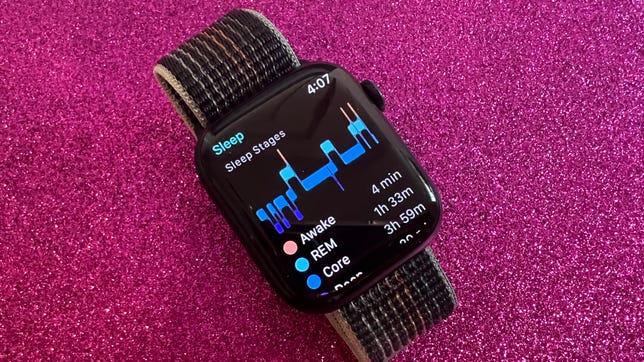 Why You Can Trust CNET
Why You Can Trust CNET Apple Watch Series 8 Review: Degrees of Difference
Next to the Apple Watch Ultra, the Series 8 may be too subtle an upgrade for many. But its health features feel more evolved than ever.
The Apple Watch Series 8, starting at $399 (£419, AU$629), joins the temperature-sensing wearable pack with a new wrist sensor of its own. Temperature-sensing wearables have been a trend these past few years, from the Fitbit Sense to the Oura Ring, Amazon's Halo band and Samsung's Galaxy Watch 5. A few weeks ago, I got sick and a little ring on my finger let me know my temperature was elevated. So, in my experience, temperature reading isn't just another check-the-box feature.
Also, this isn't the only new Apple Watch. The lower-cost Apple Watch SE and more expensive Apple Watch Ultra make a broad range, going from $249 up to $799 and beyond.

Apple Watch Series 8
Like
- Fast performance
- Temperature tracking and car-crash detection
- WatchOS 9 upgrades are great
Don't like
- Battery life isn't improved
- Not much analysis of temperature results
- Similar feel to last year's Series 7
This year, with three new Apple Watches, the challenge is knowing which one to get -- if any. Apple's use of temperature, however, might not be enough to consider an upgrade to the Series 8 this year, especially if you already own a Series 7 or Series 6. Still, the Series 8 is likely the best middle-of-the-road choice, with the one exception of unchanged battery life.
The Apple Watch Series 8 adds a temperature sensor. But how it performs over time is still TBD.
After wearing Apple's latest watch on my wrist for a couple of weeks, the Series 8 looks identical to last year's Apple Watch Series 7 and has most of the same features. New to the 8 is its temperature sensor, along with improved gyroscope and accelerometer motion sensors that are now able to detect car crashes and make SOS calls in the event of an emergency.
I didn't test the car-crash feature, for obvious reasons. And temperature data isn't being used by Apple to calculate deeper insights or health guidance yet, beyond being used to help track ovulation. Both features could very well end up being useful over time, but how useful remains to be seen. But without an upgraded battery life, this watch still doesn't feel ideally suited for overnight sleep and temperature tracking.
The best part of the Apple Watch this year is its software improvements. WatchOS 9 adds a number of extras that are really great: A compass app that now tracks your steps via GPS to help you navigate back home during hikes, medication tracking, multistage sleep tracking and a low-power mode that shuts down some functions to extend battery life. But you don't need a new watch for these; a free update to WatchOS 9 could give you these upgrades and make you feel like you already have a new watch.
Apple's approach to improving its watch over time has been a steady accumulation of upgrades -- an always-on display one year, blood oxygen the next, a slightly larger display and now temperature sensing. Skipping a bunch of years between upgrades can end up adding a lot of new features in one big bunch, but anyone who has a Series 7 will have a hard time justifying the purchase.
Temperature sensing shows up in the Health app. Readings are relative, so you'll only see increases or decreases, not absolute numbers.
Apple Watch Series 8 temperature sensing
Apple's temperature sensor measures skin temperature, similar to how other wearables work. It also measures air or water temperature (water temperature readings can show up in some apps that use the sensor). The sensor looks at relative temperature change, showing relative increases or decreases in degrees. (You can also see specific wrist temperature measurements, but the numbers are different from standard body temperature readings, making them something I wouldn't use.)
The measurements are collected at night while sleeping, and it takes five days for the watch to collect enough data to establish a starting baseline. (According to Apple, the baseline temperature will keep calibrating over time.) From that point on, the measurements only show up in Apple's Health App on the iPhone, under Skin Temperature. I could check the chart and see what my temperature changes were, but Apple's not currently alerting wearers of changes on their wrist, or any other way. The measurements also aren't being used for any sort of Readiness or Wellness score, like companies such as Fitbit and Oura are already doing. Apple is likely going to spend the next year, at least, trying to figure out how to surface that data more. In the meantime, maybe you want to wait before deciding if the sensor plays into the value of the watch.
One more immediately useful area for temperature-sensing data is ovulation tracking, another new watch feature. Similar to how Fitbit and Oura already work, the temperature shifts are used to track fertility cycles, as well as possible interruptions. CNET will test this over the next few months, much as we have with other trackers. And a word about privacy for this type of data: Apple says its Health data remains encrypted on the user's account and in iCloud, and if two-factor authentication is turned on, no one else can access it.
One of the new WatchOS 9 watch faces: Stunning, but you don't need a new watch to enjoy it.
Apple Watch Series 8 car-crash detection
Apple's improved motion sensors on the Watch 8 are being put to use for crash detection, which the iPhone (and other devices) can already do in some instances. Much like Apple's fall detection feature on its watches, it's potentially a life-saving feature if it can sense a crash and make an emergency call while someone is debilitated. However, knowing how reliable this feature can be is something we just can't determine yet. I love the idea of watches as safety-monitoring tools, though, but Apple also includes car-crash detection on the cheaper Apple Watch SE.
On a side note, I'm curious what else the more accurate gyroscope and accelerometer could be used for. Would these sensors be able to more accurately track other body movements or activities over time when new algorithms are refined? Or could they be used to improve gesture tracking? Or, as Apple approaches the release of its expected AR/VR headset, would improved motion controls be a doorway to controls for mixed reality? I'm heading down a road of pure speculation, but I'd be surprised if car-crash detection was all they were capable of.
Sleep tracking is improved, but battery life isn't.
Apple Watch Series 8 battery life: Unchanged
One big missing piece to the midrange Apple Watch is its battery. If you want better battery life, the Apple Watch Ultra can last an estimated 36 hours or more on a charge, but it costs $799. The Apple Watch Ultra is big and rugged, and CNET found its features worth the splurge for serious outdoor types.
Battery life factors in more now that the Apple Watch is shifting to a wear-to-bed type of device. Sleep tracking is now a full-featured part of WatchOS 9, and temperature tracking needs a night's sleep to measure. That's a problem when the Apple Watch's battery life is still only about a day and a half. The watch charges up fully in about an hour and a half, or up to 80% in 45 minutes or so, but when will you charge it? Before bed? In the morning while showering? At your desk?
I wore the Series 8 to bed one night after being fully charged, wore it the whole next day, to bed again, and it was at 34% battery the next morning. You could make it through a day or more without charging, but since the Apple Watch has its own proprietary charger, you'll have to make sure you're not stuck somewhere with it running low.
I tend to be a charge-at-night person, or with longer-battery wearables like the Oura Ring or the Fitbit Sense, I wear them for days before needing to worry. It feels like the Apple Watch Series 8 is caught in the middle right now. That low-power mode won't help, either, because it turns off temperature tracking and heart rate in order to get those longer-life battery gains. Maybe you could flip back and forth between modes, perhaps? Still, I'd place "bigger battery" at the top of my Apple Watch Series 9 wish list.
I haven't lived with low-power mode much yet, but I'm curious to see how it impacts battery life over the next few weeks.
The Apple Watch Ultra, Series 8 and SE. All should perform well now, but the feature sets scale up.
Apple Watch Series 8 vs. SE and Ultra: Should you upgrade?
The Apple Watch Ultra has a more durable design, longer battery and better water resistance. Is it the better choice? The new Apple Watch SE, which lacks blood oxygen, ECG, an always-on display and temperature sensing, might be a good pick for someone who doesn't need as much (but the lack of an always-on display isn't ideal). And will temperature tracking feel useful over time, along with ovulation tracking?
There's little reason to upgrade to the Series 8 if you have a Series 7, or even a Series 6. But, the Apple Watch Series 8 is the most complete health watch in Apple's lineup that doesn't need an upgrade to the Ultra.
The good news about Apple's new and improved watch lineup is the processors should all be equally fast, but the design and features scale up. Buying last year's Series 7 if it's on sale is an excellent alternative, but the 8's biggest draw over the SE right now is its always-on display, slightly bigger screen and its extra ECG, blood oxygen and temperature sensors.
Check back here over the next month or two, and we'll answer this more clearly. For now, the Apple Watch Series 8 remains an excellent piece of watch hardware with improved software and a health sensor that could be a factor down the road. But first, check your wrist: You may already have an Apple Watch that's good enough.

